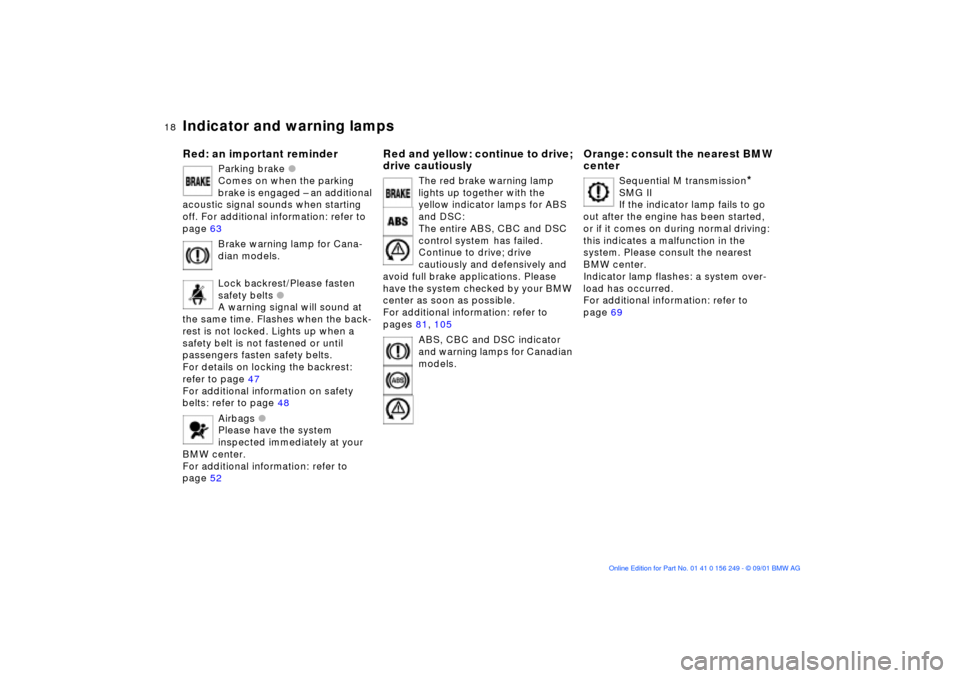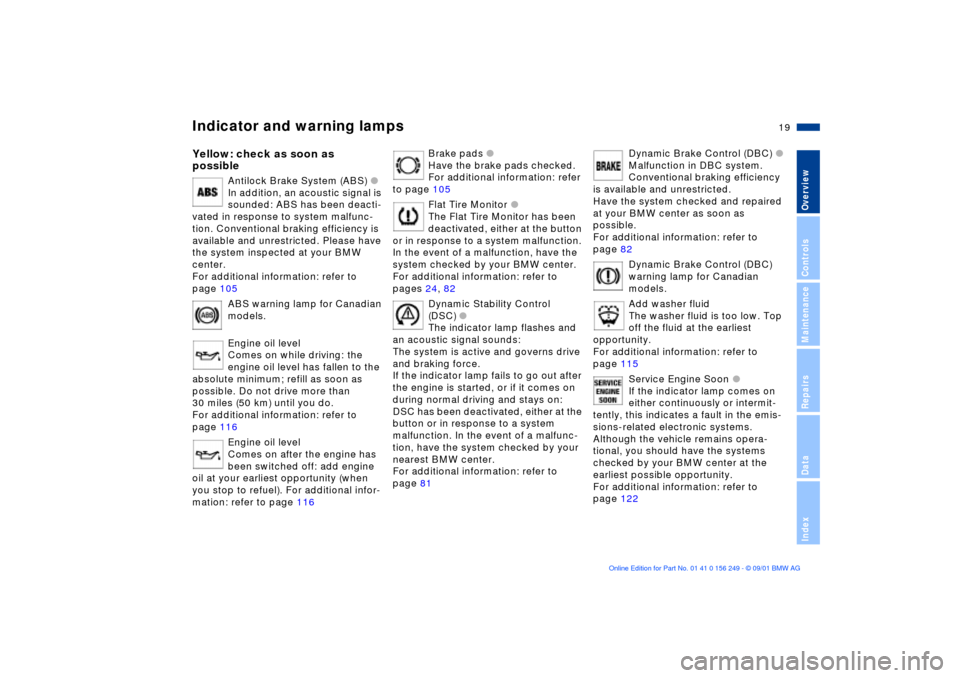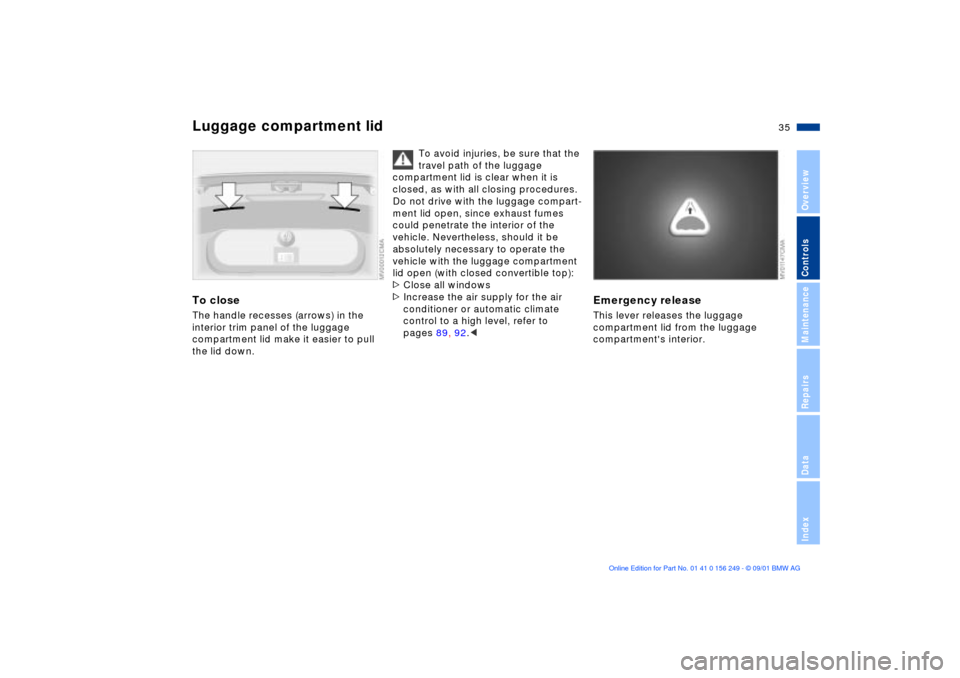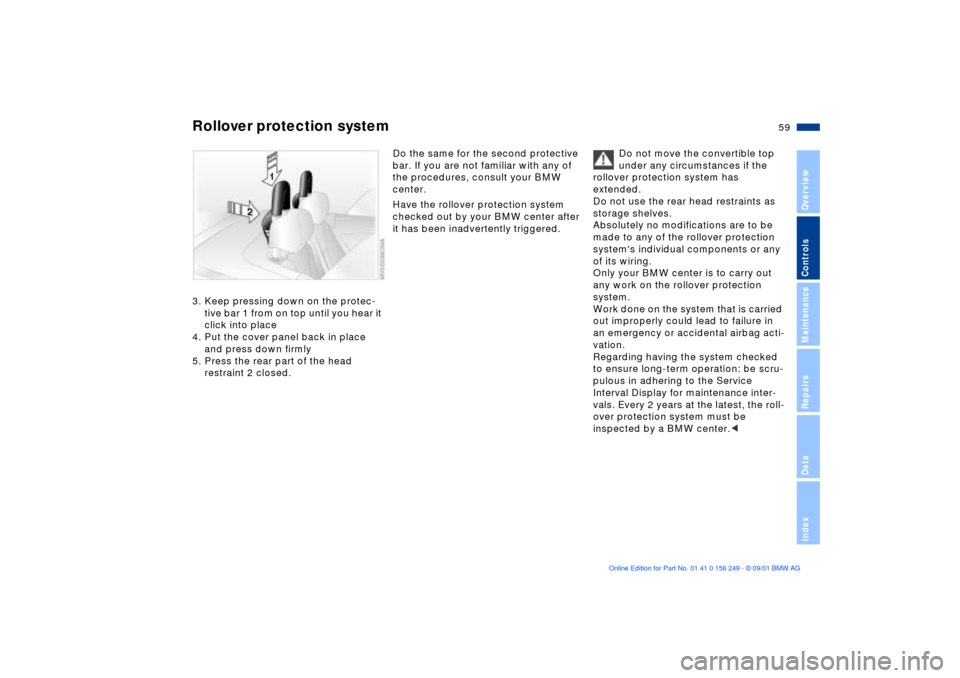ABS BMW M3 CONVERTIBLE 2002 E46 Owner's Manual
[x] Cancel search | Manufacturer: BMW, Model Year: 2002, Model line: M3 CONVERTIBLE, Model: BMW M3 CONVERTIBLE 2002 E46Pages: 159, PDF Size: 2.19 MB
Page 18 of 159

18n
Indicator and warning lamps
Red: an important reminder
Parking brake
l
Comes on when the parking
brake is engaged Ð an additional
acoustic signal sounds when starting
off. For additional information: refer to
page 63
Brake warning lamp for Cana-
dian models.
Lock backrest/Please fasten
safety belts
l
A warning signal will sound at
the same time. Flashes when the back-
rest is not locked. Lights up when a
safety belt is not fastened or until
passengers fasten safety belts.
For details on locking the backrest:
refer to page 47
For additional information on safety
belts: refer to page 48
Airbags
l
Please have the system
inspected immediately at your
BMW center.
For additional information: refer to
page 52
Red and yellow: continue to drive;
drive cautiously
The red brake warning lamp
lights up together with the
yellow indicator lamps for ABS
and DSC:
The entire ABS, CBC and DSC
control system
has failed.
Continue to drive; drive
cautiously and defensively and
avoid full brake applications. Please
have the system checked by your BMW
center as soon as possible.
For additional information: refer to
pages 81, 105
ABS, CBC and DSC indicator
and warning lamps for Canadian
models.
Orange: consult the nearest BMW
center
Sequential M transmission
*
SMG II
If the indicator lamp fails to go
out after the engine has been started,
or if it comes on during normal driving:
this indicates a malfunction in the
system. Please consult the nearest
BMW center.
Indicator lamp flashes: a system over-
load has occurred.
For additional information: refer to
page 69
Page 19 of 159

19n
OverviewControlsMaintenanceRepairsDataIndex
Indicator and warning lamps
Yellow: check as soon as
possible
Antilock Brake System (ABS)
l
In addition, an acoustic signal is
sounded: ABS has been deacti-
vated in response to system malfunc-
tion. Conventional braking efficiency is
available and unrestricted. Please have
the system inspected at your BMW
center.
For additional information: refer to
page 105
ABS warning lamp for Canadian
models.
Engine oil level
Comes on while driving: the
engine oil level has fallen to the
absolute minimum; refill as soon as
possible. Do not drive more than
30 miles (50 km) until you do.
For additional information: refer to
page 116
Engine oil level
Comes on after the engine has
been switched off: add engine
oil at your earliest opportunity (when
you stop to refuel). For additional infor-
mation: refer to page 116
Brake pads
l
Have the brake pads checked.
For additional information: refer
to page 105
Flat Tire Monitor
l
The Flat Tire Monitor has been
deactivated, either at the button
or in response to a system malfunction.
In the event of a malfunction, have the
system checked by your BMW center.
For additional information: refer to
pages 24, 82
Dynamic Stability Control
(DSC)
l
The indicator lamp flashes and
an acoustic signal sounds:
The system is active and governs drive
and braking force.
If the indicator lamp fails to go out after
the engine is started, or if it comes on
during normal driving and stays on:
DSC has been deactivated, either at the
button or in response to a system
malfunction. In the event of a malfunc-
tion, have the system checked by your
nearest BMW center.
For additional information: refer to
page 81
Dynamic Brake Control (DBC)
l
Malfunction in DBC system.
Conventional braking efficiency
is available and unrestricted.
Have the system checked and repaired
at your BMW center as soon as
possible.
For additional information: refer to
page 82
Dynamic Brake Control (DBC)
warning lamp for Canadian
models.
Add washer fluid
The washer fluid is too low. Top
off the fluid at the earliest
opportunity.
For additional information: refer to
page 115
Service Engine Soon
l
If the indicator lamp comes on
either continuously or intermit-
tently, this indicates a fault in the emis-
sions-related electronic systems.
Although the vehicle remains opera-
tional, you should have the systems
checked by your BMW center at the
earliest possible opportunity.
For additional information: refer to
page 122
Page 35 of 159

35n
OverviewControlsMaintenanceRepairsDataIndex
Luggage compartment lidTo closeThe handle recesses (arrows) in the
interior trim panel of the luggage
compartment lid make it easier to pull
the lid down.
To avoid injuries, be sure that the
travel path of the luggage
compartment lid is clear when it is
closed, as with all closing procedures.
Do not drive with the luggage compart-
ment lid open, since exhaust fumes
could penetrate the interior of the
vehicle. Nevertheless, should it be
absolutely necessary to operate the
vehicle with the luggage compartment
lid open (with closed convertible top):
>Close all windows
>Increase the air supply for the air
conditioner or automatic climate
control to a high level, refer to
pages 89, 92.<
Emergency releaseThis lever releases the luggage
compartment lid from the luggage
compartment's interior.
Page 44 of 159

44n
For relaxed and fatigue-free driving you
should select a sitting position that
reflects your personal requirements.
Correct position combines with safety
belts and airbags to enhance occupant
safety in the event of an accident. To
ensure that the vehicle's safety systems
provide you with optimal protection, we
request that you direct your careful
attention to the following section.
For supplementary information on
transporting children, refer to page 54.
Sitting correctly with airbags
Always maintain an adequate
distance between yourself and the
airbags. Always hold the steering wheel
by the rim to keep any chance of injury
to hands or arms to an absolute
minimum should the airbag be
deployed. Never allow any objects,
individuals or animals to obstruct the
areas between passengers and airbags.
Never use the front airbag's cover as a
storage tray or support for objects of
any kind. Never allow front passengers
to rest their feet or legs on the airbag
cover.<
For airbag locations and additional
information on airbags refer to page 53.
Safe with safety belts
Never allow more than one person
to wear a single safety belt. Never
allow infants or small children to ride in
a passenger's lap. Avoid twisting the
belt while routing it firmly across the
pelvis and shoulder, wear it as snugly
against your body as possible. Do not
allow the belt to rest against hard or
fragile objects in your pockets. Do not
route the belt across your neck, or run it
across sharp edges. Be sure that the
belt does not become caught or
jammed. Avoid wearing bulky clothing
and pull on the lap belt periodically to
retension it over your shoulders. In the
event of a frontal impact, a loose lap
belt could slide over the hips, leading to
abdominal injury. In addition, the safety
belt's restraint effectiveness is reduced
if the belt is worn loosely. Expectant
mothers should always wear their
safety belts, taking care to position the
lap belt against the lower hips, where it
will not exert pressure against the
abdominal area. Leave the rear safety
belts in the holders, if they are not
needed, to avoid unwanted movement
from the safety belts at high speeds.<
For information on using the safety
belts, refer to page 48.
When adjusting your seat, always
observe the following precautions
Never try to adjust your seat while
operating the vehicle. The seat
could respond with an unexpected
movement, and the ensuing loss of
vehicle control could lead to an acci-
dent. Never ride with the backrest
reclined to an extreme angle (especially
important for the front passenger to
remember). If you do so, there is a risk
that you will slide under the safety belt
in an accident, thus reducing the
protection provided by the safety belt.
With the wind deflector in place: never
push the front seats all the way back to
avoid damaging the wind deflector.<
Correct sitting position Seats
Page 59 of 159

59n
OverviewControlsMaintenanceRepairsDataIndex
Rollover protection system3. Keep pressing down on the protec-
tive bar 1 from on top until you hear it
click into place
4. Put the cover panel back in place
and press down firmly
5. Press the rear part of the head
restraint 2 closed.
Do the same for the second protective
bar. If you are not familiar with any of
the procedures, consult your BMW
center.
Have the rollover protection system
checked out by your BMW center after
it has been inadvertently triggered.Do not move the convertible top
under any circumstances if the
rollover protection system has
extended.
Do not use the rear head restraints as
storage shelves.
Absolutely no modifications are to be
made to any of the rollover protection
system's individual components or any
of its wiring.
Only your BMW center is to carry out
any work on the rollover protection
system.
Work done on the system that is carried
out improperly could lead to failure in
an emergency or accidental airbag acti-
vation.
Regarding having the system checked
to ensure long-term operation: be scru-
pulous in adhering to the Service
Interval Display for maintenance inter-
vals. Every 2 years at the latest, the roll-
over protection system must be
inspected by a BMW center.<
Page 82 of 159

82n
Dynamic Stability Control (DSC) Flat Tire MonitorTo deactivate the systemPress the button; the indicator lamp
comes on and stays on.
The vehicle does not execute the
stability-enhancement and traction-
control functions when DSC is deacti-
vated.
We recommend that you deactivate the
system for increased traction:
>when rocking the vehicle or starting
off in deep snow or on loose surfaces
>or when driving with snow chains.
To maintain vehicle stability,
always drive with the system
switched on whenever possible.<
To reactivate the systemPress the button again; the indicator
lamp goes out.Dynamic Brake Control (DBC)DBC is an integral component of the
DSC system.
If you apply the brakes rapidly, this
system automatically generates
maximum braking force boost and thus
helps to achieve the shortest possible
braking distance in "panic braking" situ-
ations. All of the benefits of the ABS
system are exploited under these
circumstances.
Do not reduce the pressure on the
brake pedal for the duration of the
brake application. When the brake
pedal is released, the DBC is deacti-
vated.
The conceptThe Flat Tire Monitor keeps track of the
inflation pressures in your tires as you
drive. The system detects whenever the
inflation pressure in a tire drops off
significantly.
Controlling the tire pressure is based
on monitoring the rpms that the tires
have relative to each other. A flat tire is
detected and reported because the
rpms suddenly deviate drastically from
one another.
Page 105 of 159

105n
OverviewControlsMaintenanceRepairsDataIndex
Brakes: do not rest your foot on
the brake pedal while driving.
Even light but consistent pedal pres-
sure can lead to high temperatures,
brake wear and possibly even brake
failure.
Aquaplaning: when driving on wet or
slushy roads, reduce road speed. If you
do not, a wedge of water can form
between tires and road surface. This
phenomenon is referred to as aqua-
planing, or hydroplaning, and can lead
to partial or complete loss of traction,
vehicle control and braking effective-
ness.
Driving through water: do not drive
through water on the road if it is deeper
than 1 foot (30 cm), and then only at
walking speed. Otherwise the vehicle
can sustain damage to the engine, the
electrical systems and the transmis-
sion.<
The conceptThe Antilock Brake System (ABS) keeps
the wheels from locking while braking,
thereby enhancing active driving safety.Braking with ABSIf you are in a situation that requires full
braking, you will exploit the full benefits
of the ABS system if you apply
maximum brake pressure ("panic
stop"). Since the vehicle maintains
steering responsiveness, you can
nevertheless avoid possible obstacles
with a minimum of steering effort.
Pulsation at the brake pedal combines
with sounds from the hydraulic circuits
to indicate to the driver that ABS is in
its active mode.Cornering Brake Control (CBC)CBC is an advanced engineering
design of the ABS. When braking while
cornering at high speed or braking
during high lateral acceleration, or
when braking during a lane change,
vehicle stability is improved and
steering response is enhanced.
Brake fluid level Low brake fluid level in the reservoir
combined with longer than usual pedal
travel may indicate a defect in one of
the brake system's hydraulic circuits.
Proceed to the nearest BMW
center. Higher brake application
pressure may be necessary when stop-
ping, and the vehicle may exhibit a
slight tendency to pull to one side.
Brake distances may even be longer.
Please remember to adapt your driving
style accordingly.<
Driving notes Antilock Brake System Brake system
Page 106 of 159

106n
Brake system Hardtop
*
Disc brakesWhen the vehicle is driven only occa-
sionally, during extended periods when
the vehicle is not used at all, and in
operating conditions where brake appli-
cations are less frequent, there is an
increased tendency for corrosion of the
rotors and accumulation of contamina-
tion on the brake pads. This occurs
because the minimal pressure that must
be exerted by the pads to clean the
rotors by brake applications is not
reached.
Corrosion on brake rotors is signaled by
a running or pulsation during braking;
even extended subsequent braking will
not cure this phenomenon.
It is a good idea to periodically dry the
brakes with a gentle application when
driving in rain and on wet roads. Watch
traffic conditions to ensure that this
maneuver does not endanger other
road users. The heat generated in this
process helps dry the pads and rotors
to ensure that your brake system will
respond with undiminished efficiency
when you need it.Extended or steep mountain descents
should be driven in the gear in which
only minimal periodic brake applica-
tions are required. This helps avoid
placing excessive loads on the brake
system. Stay within the allowable
engine speed range. For further infor-
mation, refer to page 75.
Do not coast with the clutch
depressed or with the gearshift
lever in idle position. Do not coast with
the engine shut off. If you do so the
engine provides no braking effect and
there is no power assist for braking or
steering when the engine is not
running.<
Brake pads
For your own safety: use only
brake pads which BMW has
approved for your specific vehicle
model. BMW cannot evaluate non-
approved brake pads to determine if
they are suited for use, and therefore
cannot ensure the operating safety of
the vehicle if they are installed.<
It is not necessary to remove the fabric
top even in the winter, when the
hardtop is generally in constant use.
But you can also remove it at any time
with no problem. Before the fabric top
is stored in the convertible top
compartment, it must be absolutely dry
in order to avoid water spot and mildew
from forming.
The hardtop offers reading lamps and
clothing hooks that can be used just by
pressing. In addition, a roof-rack
assembly is possible. In this regard,
please contact your BMW center.
When suspending articles of
clothing from the hooks, be sure
that they will not obstruct the driver's
vision. Do not hang heavy objects on
the hooks. If you do so, they could
cause personal injury during braking or
evasive maneuvers.<
Page 111 of 159

111n
OverviewControlsMaintenanceRepairsDataIndex
Tire replacement Wheel and tire combinations Tire ageBMW recommends the replacing of all
tires after 6 years at the latest, even if a
tire life of 10 years is possible.
The date on which the tire was manu-
factured is indicated by the code on the
sidewall:
DOT ... 3501 indicates that the tire was
manufactured in week 35 of the year
2001.Following wheel/tire changesFollowing wheel and/or tire changes
you will need to reinitialize both the Flat
Tire Monitor and the sequential M
gearbox
* SMG II, refer to pages 70, 83.
The right choice
Never mount wheels and tires that
have not been specifically
approved by BMW for use on your
particular model. Although other wheels
and tires may theoretically have the
same dimensions, variations in factors
such as manufacturing tolerances can
result in contact between tire and body-
work, ultimately leading to serious acci-
dents. If non-approved wheels and tires
are used, BMW cannot evaluate their
suitability, and therefore cannot be held
liable for driving safety.<
BMW tests certain tire brands for each
tire size, classifies them as road-safe
and approves them. Consult your BMW
center for more information. Observe
any country-specific regulations, e.g.
on making a corresponding entry in the
vehicle documents.
The correct wheel and tire combi-
nation affects different systems
such as ABS, DSC, Flat Tire Monitor.
The function of these systems is
impaired if improper wheel and tire
combinations are used.
Therefore, only use tires of the same
brand and same tread configuration on
the vehicle and, for example following a
tire failure, restore the approved wheel
and tire combination as soon as
possible.<
The use of rims and lug bolts that
do not meet the specifications of
the original factory-installed equipment
will affect the safe operation of your
vehicle and may cause an accident and
personal injury.
Never mix tires of different design, such
as steel-belted radials with radial bias-
belted or bias-ply tires, etc. Mixing tire
types will adversely affect roadholding
and can lead to loss of vehicle
control.< Storage Store wheels and tires in a cool, dry
place, protecting them against light
whenever possible. Protect the tires
against contact with oil, grease and
fuel.
Page 119 of 159

119n
OverviewControlsMaintenanceRepairsDataIndex
Brake fluid
If the brake warning lamp
comes on with the parking
brake released: the brake fluid
level is too low.
For adding brake fluid or for
determining and correcting the
cause of brake fluid loss, consult your
BMW center. Your BMW center is
familiar with the specifications for
factory-approved brake fluids (DOT 4).
Due to loss in brake fluid, pedal travel
can lengthen and braking efficiency
may be reduced. Comply with the infor-
mation provided on page 105.
Brake fluid is hygroscopic, that is,
it absorbs moisture from the air
over time.
In order to ensure the safety and reli-
ability of the brake system, have the
brake fluid changed every two years by
a BMW center. Refer also to the Service
and Warranty Information Booklet (US
models) or the Warranty and Service
Guide Booklet (Canadian models).
Brake fluid is toxic and damages the
vehicle's paint. You should always store
it in its original container and in a loca-
tion inaccessible to children.
Do not spill the fluid and do not fill the
brake fluid reservoir beyond the "MAX"
mark. The brake fluid could ignite upon
contact with hot engine parts and
cause serious burns.<
Comply with the applicable envi-
ronmental laws regulating the
disposal of brake fluid.<